Introduction: Myanmar’s Cultural Significance
Myanmar, formerly known as Burma, is a country located in Southeast Asia and is home to a rich and diverse cultural heritage. The people of Myanmar are known for their warm hospitality and friendly nature, which is reflected in their dining customs and etiquette.
In Myanmar, sharing a meal is not just about satisfying hunger but also a way to show respect, gratitude, and strengthen relationships. Dining customs in Myanmar are closely intertwined with the country’s religious and cultural practices, and visitors are expected to respect and adhere to these customs while dining in the country.
Table Manners and Respect for Elders
In Myanmar, showing respect for elders is of utmost importance, and this is reflected in their dining customs. When dining with elders, it is considered respectful to wait for them to take their seat and start eating before beginning to eat. It is also customary to serve the elders first and wait for them to finish before starting to eat.
Table manners are essential in Myanmar, and slurping, burping, or making loud noises while eating is considered impolite. It is also considered rude to waste food or leave food on your plate, as it is seen as a sign of disrespect towards the host.
Myanmar’s Traditional Seating Arrangements
Myanmar’s traditional seating arrangements are unique and reflect the country’s cultural practices. In Myanmar, it is customary to sit on the floor while eating, and meals are usually served on a low table called a “tiffin.” Guests are expected to sit cross-legged or with their legs folded to the side, with their feet pointing away from the table.
The seating arrangement at a meal is significant in Myanmar, and guests are seated according to their social status. The most senior guests are seated closest to the head of the table, while the youngest or least senior guests are seated towards the foot of the table.
Sharing Food and Communal Dining
Sharing food is an essential part of Myanmar’s dining customs, and communal dining is common. It is customary for guests to share dishes and to take a small portion of each dish rather than having a large plate of food to themselves.
In Myanmar, it is also considered polite to offer food to others before serving yourself. Guests are also encouraged to try a little of everything that is served, as it is seen as a sign of respect towards the host.
Burmese Tea Culture and Hospitality
Burmese tea culture is an integral part of Myanmar’s dining customs and is a way of showing hospitality towards guests. Tea is usually served before and after a meal and is accompanied by small snacks such as fried beans or samosas.
In Myanmar, it is customary for the youngest or least senior person at the table to pour tea for the elders or the most senior guests. Pouring tea is seen as a sign of respect, and guests are expected to offer tea to others before serving themselves.
Final Thoughts on Myanmar’s Dining Customs
Myanmar’s dining customs are a reflection of the country’s rich cultural heritage and religious practices. Visitors to the country are expected to respect and adhere to these customs while dining in Myanmar.
From showing respect for elders to sharing food and communal dining, Myanmar’s dining customs encourage inclusivity, hospitality, and a sense of community. As a visitor to Myanmar, experiencing the country’s unique dining customs is an essential part of immersing yourself in the country’s vibrant culture.

